A History Of United States Half Cents
The Coinage Act of 1792 established not only a United States Mint and a number of key positions there, but it also created the standard unit of money as the United States Dollar.
President George Washington signed ‘An Act to Provide for a Copper Coinage,’ on May 9, 1792 which allowed the Director of the Mint to purchase copper for the minting of both copper cents and half cent coins. Interestingly, this act also provided that these cents and half cents be accepted as lawful coinage and prohibited the use of foreign copper coins and imposed both confiscation and a fine on offenders.
Henry Voigt secured the role as the nation’s first Chief Coiner at the U.S. Mint. His design for the half cent was very basic as it portrayed a bust of Miss Liberty, facing to the left. This is the Liberty Cap design of Half Cents.
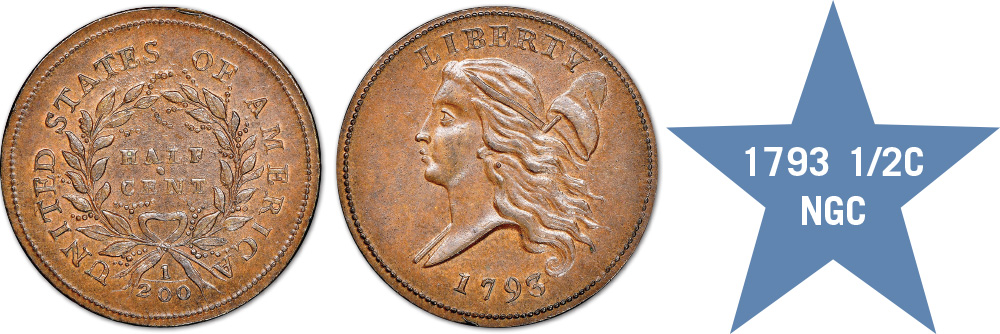
She has a stern looking portrait and long flowing hair, with a ribbon holding it in place. Behind her is a Phrygian cap on a pole, which since the days of ancient Greece has been the head covering of free men and since the days of ancient Rome was worn by emancipated slaves. Even centuries later, it was meant to symbolize freedom and liberty. Below the bust is the date 1793. The obverse is surrounded around the periphery by a beaded border design, unique to this inaugural year.
The reverse wreath is very elaborate with leaves, stems and berries and displayed. Inside the wreath are the words HALF CENT, and around the periphery are UNITED STATES OF AMERICA, and 1/200. The beaded border is also present on the reverse.
The edge is inscribed with TWO HUNDRED FOR A DOLLAR. A mere 35,334 coins were struck. But Voigt’s design was not greatly appreciated and 1794 gave the Mint the opportunity to change the design and make this new coin more acceptable to the public.
The 1794 coin was very likely engraved by Robert Scot, who served as Chief Engraver of the United States Mint from 1793 until his death in 1823. David Rittenhouse, who was the first Director of the United States Mint, is purported to have hired Jospeh Wright to design the obverse of the 1794 Half Cent. The Mint needed to address the objections raised by the public and by those at the Mint who did not like the 1793 Half Cent.
The obverse of the 1794 Half Cent was extensively changed. Now, Miss Liberty faced to the right, instead of the left. The word LIBERTY was still above the head of Miss Liberty on the upper periphery and the date still resided below her. Her hair was full and flowing and Miss Liberty showed a bit more maturity and a hint of smile in the later design. The Phrygian Cap was still residing on a liberty pole behind Miss Liberty.
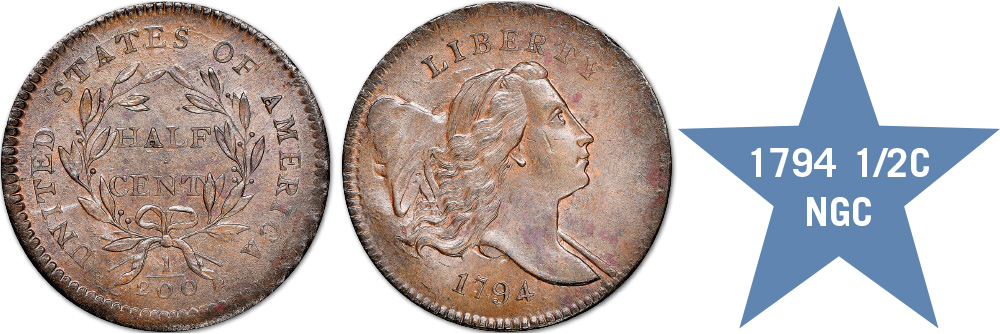
The reverse was now tied with a double bow, binding the base of the wreath. The legends all remained the same in the same positions as did the denomination located within the wreath. These coins, using the same design, were struck annually between 1794 and 1797. The mintages grew considerably higher from the 1793 issue, except for the 1796 issue of less than 6,500 coins for all varieties.
No Half Cents were struck in 1798 and 1799, in large measure due to the Yellow Fever epidemic in Philadelphia and in New York City. In 1800 it is believed that the new Director of the United States Mint, Henry William DeSaussure, who became Director in 1795, was likely the one who reached outside the Mint to colonial portrait artist, Gilbert Stuart.
Stuart made sketches of Miss Liberty and John Eckstein, a Philadelphia artist, made plaster models to assist Robert Scot in doing the engraving of the dies.
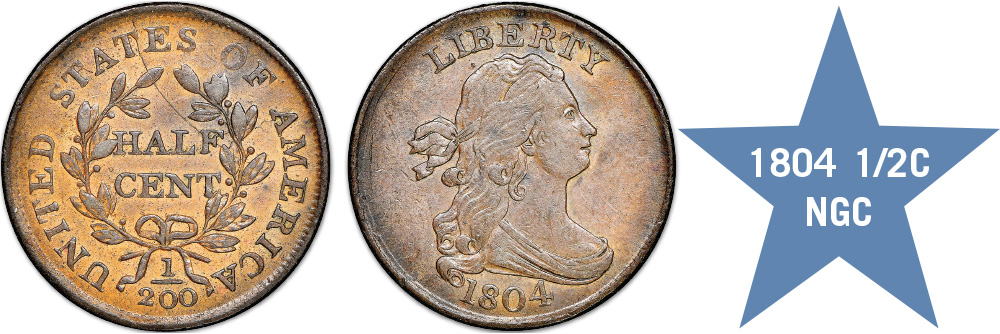
The appearance of Miss Liberty was quite different and much more pleasing. She had a more human and more feminine appearance than in previous versions. Her curly hair was more styled and had a ribbon keeping it neat and back. Instead of her bust being truncated at her neck, this new version displayed her wearing a flowing gown to her shoulders.
The reverse presented a similar, though less-detailed wreath, which was now comprised of olive leaves, and it had the same legends and denomination present. Mintages increased to several hundred thousand until 1804, when 1,055,312 coins were struck. Coins with this design are called the Draped Bust half cents and they were struck between 1800 and 1808. However, no half cents dated 1801 were struck due to the excess of 1800-dated half cent coins that were struck and the low-demand for the small denomination copper coin.
In 1809, there was a new design for the half cent coin. John Reich, the U.S. Mint’s Second Engraver, designed the coin as Chief Engraver Robert Scot’s eyesight was failing. The new design, called the Classic Head or Turban Head, modified the obverse of the previous design.
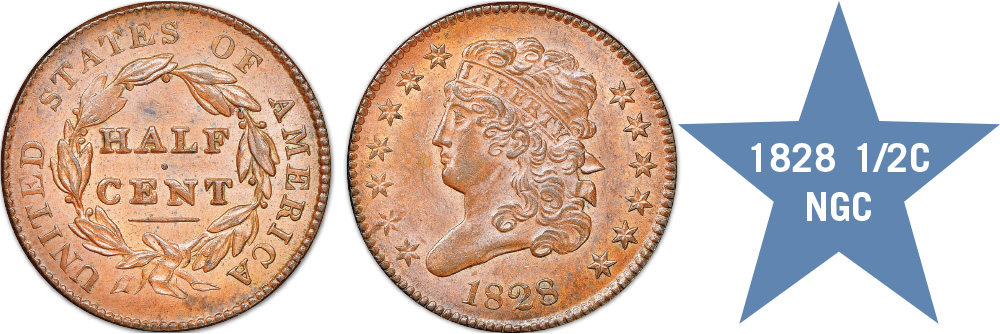
Miss Liberty now, once again, faced the left, but her countenance was more mature-looking. The word LIBERTY no longer adorned the upper periphery of the coin. It was now inscribed on Liberty’s headband. Around the new design of Miss Liberty were 13 five-pointed stars, with the date positioned below the bust. The older-looking Miss Liberty and the presence of her headband gave this design the nicknames the Matron Head or Coronet Head, neither of which were as popular as the Classic Head.
The reverse retained the traditional HALF CENT, inside a wreath with UNITED STATES OF AMERICA, around the periphery. There is also a raised center dot between HALF, and CENT. These Classic Head coins were issued in 1809, 1810, 1811 and then not again until 1825. Additional coins were dated 1826, 1828, and 1829.
In 1831, the U.S. Mint acquired new coinage presses and other equipment and Proof Half Cents were struck for the first time. Approximately 2,200 1831-dated proofs were struck and as many as 50 1831-dated Proof restrikes were struck between 1858 and 1861.
Proof and business strike coins were issued annually between 1832 and 1835. Nearly 240 Proof coins that were dated 1836 were struck as original coins with 15 restrikes of that same date.
There were no 1837-dated half cent coins struck but because of the need for small change in commerce, a large number of privately issued tokens were issued and accepted as coinage. Additionally, no half cents were struck in 1838 or 1839.
In 1823, a new employee was engaged at the U.S. Mint. Christian Gobrecht had caught the attention of the current director of the Mint, Robert Patterson. The Director wanted to hire Gobrecht as the Assistant Director, but Gobrecht declined. He wanted to actually create and design coinage and put his stamp on American coinage.
It wasn’t until 1835 that Gobrecht was hired as the Second Chief Engraver of the Mint. William Kneass had served as the Chief Engraver since 1824. But Kneass suffered a stroke, so Gobrecht assumed the duties of the Chief Engraver.
One design he definitely wanted to change was the current Half Cent denomination. In 1840, Kneass passed which allowed Gobrecht to be named Chief Engraver.
Gobrecht went to work on changing the design of the Half Cent. He complained that the design of Miss Liberty looked like an “old lady.” His new design, for the 1840 coins, depicted a much more youthful Liberty with more stylish hair in a popular, tight braid. She looked younger and more invigorated as the country entered the 1840s.
Due to the appearance of Miss Liberty, the fourth and final design type of half cent coins were issued in 1840 and are called the Braided Hair, style coins.
Miss Liberty now faces left and has a more youthful appearance. The word LIBERTY, is emblazoned across her head band and she is surrounded by 13 six-pointed stars with the date below.
A simpler, olive wreath is dominant on the reverse and encircles the words HALF CENT, on two lines, without a center dot. The legend UNITED STATES OF AMERICA, surrounds the periphery and has prominent denticles.
The coins struck from 1840 through 1849 were proof-only issues, struck for collectors. These original coins had mintages ranging from a low of 70 coins to a high of 300 coins. Restrikes were also struck at the mint in even smaller numbers—from 15 to 47 pieces, generally only struck on demand.
From 1849 through 1857, half cents were struck for circulation and commerce. The only exception to this are the 1852-dated coins that, once again, were proof-only issues. Approximately 225 to 325 of these original proof coins were issued and only 110 to 140 restrikes were also sold.
By 1857, the costs for striking and distributing pure copper Half Cents and Large Cents had risen dramatically. Additionally, as consumer prices had risen since 1793, the commercial uses for these low denominations had also decreased. The Coinage Act of 1857 spelled the death knell for the Half Cent coin. Large Cent coins were also reduced dramatically in size to accommodate the higher copper costs.
Half Cent coins, and their larger brethren, Large Cents, are actively and enthusiastically collected. The most popular methods are by type, by date and then by major die varieties.

A Guide Book of Half Cents and Large Cents, by Q. David Bowers (Whitman Publishing) is a great reference for the beginning collector of these historic coins. There are other excellent references for the more advanced collector, but all are out of print.


Download the Greysheet app for access to pricing, news, events and your subscriptions.
Subscribe Now.

Subscribe to The Greysheet for the industry's most respected pricing and to read more articles just like this.
Author: Michael Garofalo


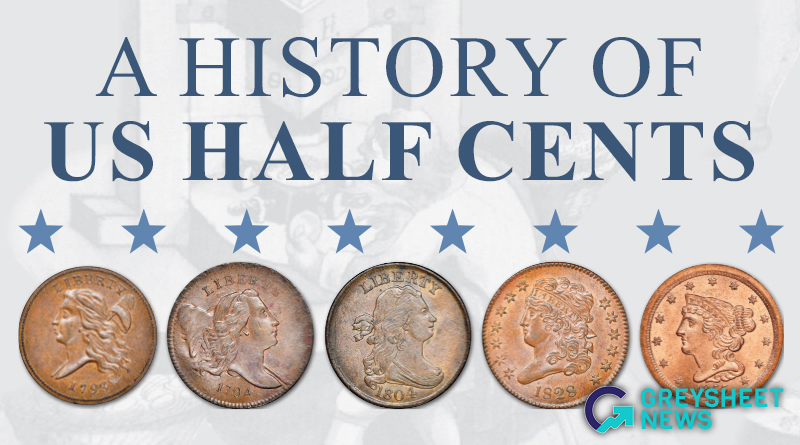






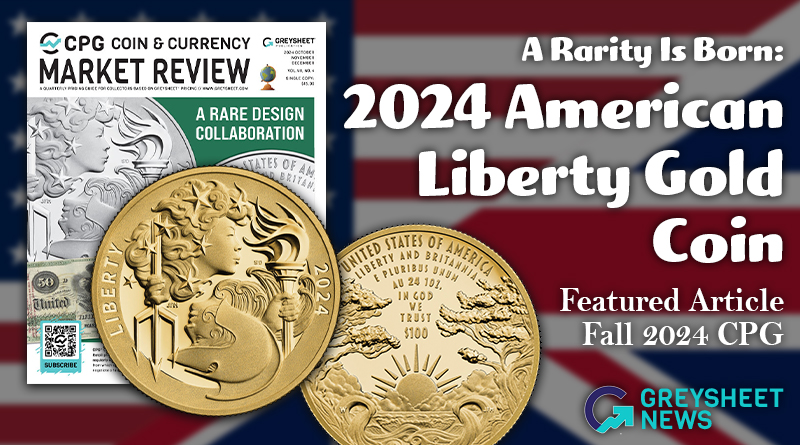
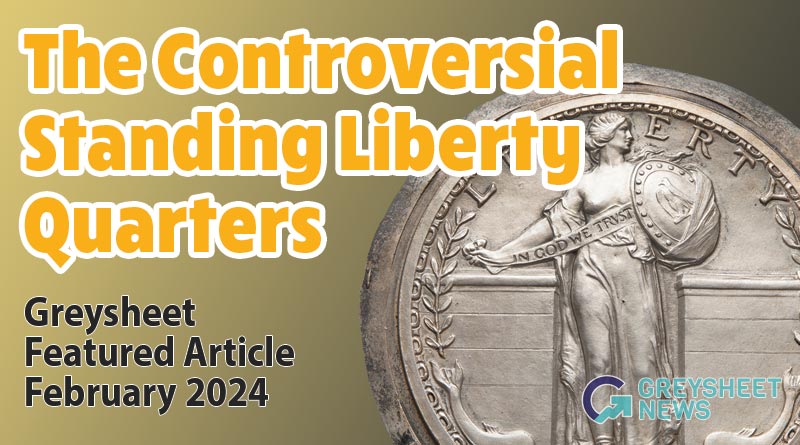
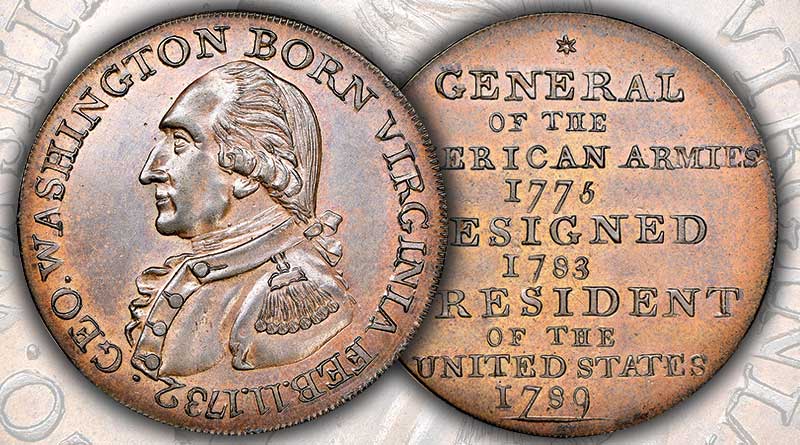
Please sign in or register to leave a comment.
Your identity will be restricted to first name/last initial, or a user ID you create.
Comment
Comments